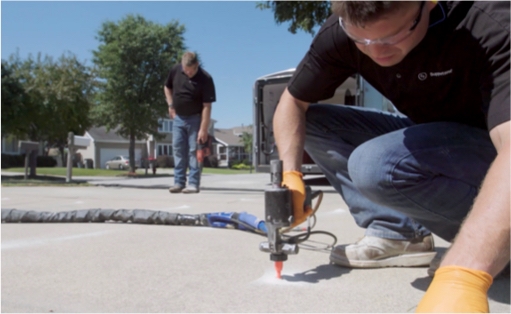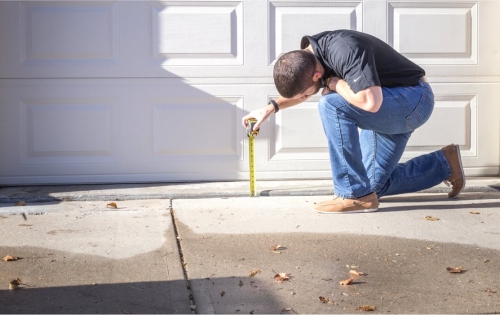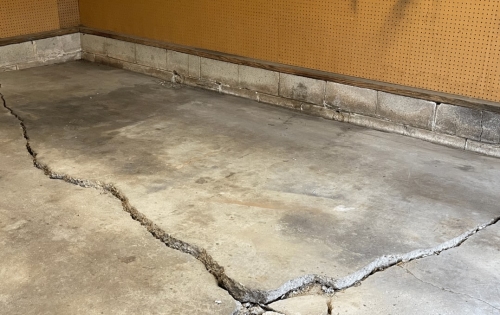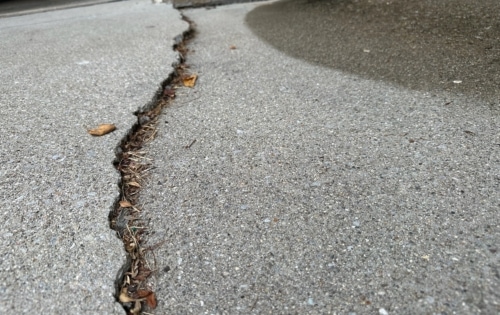Your concrete surfaces – driveways, patios, sidewalks, garage floors – take a beating over time. The freeze-thaw cycles here in Indiana, the occasional overly enthusiastic basketball game, or even just the natural settling of your house can lead to uneven, cracked, or sunken concrete. This not only looks bad but can also be a tripping hazard. But tearing out and replacing those slabs? That’s a pricey and disruptive project. Enter concrete lifting!
What is Concrete Lifting?
Concrete lifting, also known as slabjacking, is a cost-effective and minimally invasive method for repairing uneven concrete surfaces. It involves injecting a specialized material beneath the sunken concrete to raise and level it, restoring both its functionality and appearance. This process eliminates the need for demolition and replacement, saving you time, money, and hassle.
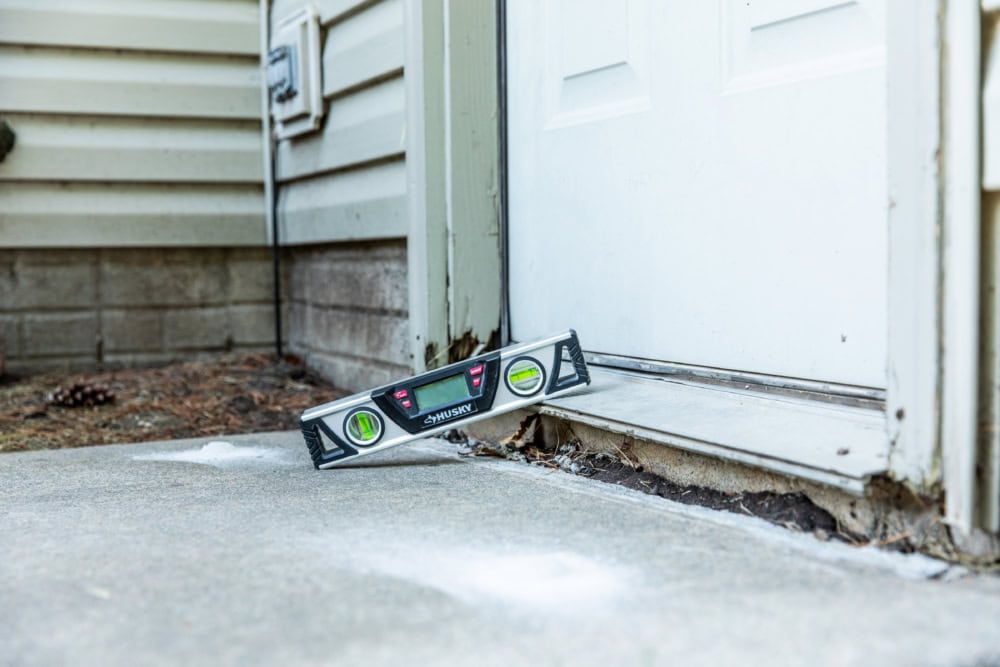
What Can Concrete Lifting Fix?
Concrete lifting is a versatile solution for a variety of common concrete problems:
- Sunken Driveways and Sidewalks: Those uneven sections that collect water and make it difficult to shovel snow? Gone.
- Cracked Patios and Pool Decks: Restore the beauty and safety of your outdoor living spaces.
- Uneven Garage Floors: No more worrying about your car leaning or water pooling.
- Interior Floor Slabs: Address uneven floors inside your home caused by foundation settlement.
- Settling Steps and Stoops: Safely and effectively level those precarious front steps.
- Uneven Concrete Around Pools: Prevent water damage and ensure the safety of your pool area.
The Concrete Lifting Process: A Step-by-Step Guide
- Assessment: A qualified technician will begin by thoroughly inspecting the affected area. This involves assessing the extent of the settlement, identifying the underlying cause, and determining the best approach for lifting the concrete.
- Drilling: Small holes are strategically drilled in the concrete slabs. The size and location of these holes depend on the specific lifting technique and the severity of the settlement.
- Injection: The lifting material – either a polyurethane foam or a cement-based grout (mudjacking) – is carefully injected through the holes. The material expands beneath the slab, gently raising it back to its original position.
- Leveling: Throughout the injection process, the technician continuously monitors the slab’s position to ensure precise leveling and achieve the desired height.
- Patching: Once the concrete is level, the small injection holes are patched with a matching material to blend seamlessly with the surrounding surface.
Concrete Lifting: Weighing the Pros and Cons
Pros:
- Cost-Effective: Concrete lifting is significantly cheaper than complete concrete replacement.
- Minimally Disruptive: No need for demolition, hauling away old concrete, or extensive landscaping repairs. Your property remains largely undisturbed.
- Fast and Efficient: Most projects can be completed in a few hours, allowing you to quickly get back to enjoying your space.
- Long-lasting Results: With proper installation, concrete lifting can provide a lasting solution, keeping your concrete level for many years.
- Increases Home Value: Improved curb appeal and safety boost your property’s value.
- Environmentally Friendly: Concrete lifting reduces waste by avoiding the need to dispose of old concrete.
Cons:
- May Not Be Suitable for Severely Damaged Concrete: In cases of extensive cracking or crumbling, replacement may be necessary.
- Continued Settlement: if not addressed for the root cause, subsequent slabs may sink – determining the root cause is ideal for long lasting repair.
- Weather during install: Ensuring ground temperatures are above freezing is important when installing to ensure proper lifting is done.
Concrete Lifting Costs: What to Expect
The cost of concrete lifting varies depending on several factors:
- Size of the area: Larger areas require more material and labor, increasing the cost.
- Type of lifting material used: Polyurethane foam generally costs more than mudjacking.
- Accessibility of the site: Difficult-to-access areas may require specialized equipment or additional labor.
- Severity of the settlement: Heavily sunken slabs may require more material and time to lift.
To get a precise estimate for your project, contact LevelUp Concrete Solutions for a free, no-obligation quote.
Polyurethane vs. Mudjacking: Choosing the Right Material
Two primary materials are used in concrete lifting: polyurethane foam and a traditional cement-based grout (often called “mudjacking”). Both are effective, but they have distinct advantages and disadvantages.
For more information on how to choose the right solution for your concrete repair, check out our Polyurethane vs. Mudjacking blog.
The Polyurethane Advantage
At LevelUp Concrete Solutions, we primarily use polyurethane foam for its superior lifting capabilities and numerous benefits Advantages of Polyurethane Foam Concrete Lifting.
Why Choose LevelUp Concrete Solutions?
With over 100 5-star reviews, LevelUp Concrete Solutions is Indianapolis and Fort Wayne’s trusted choice for concrete lifting and leveling. We’re committed to providing:
- High-Quality Materials: We use only the best polyurethane foam to ensure long-lasting results.
- Expert Technicians: Our experienced team has the skills and knowledge to handle any concrete lifting project.
- Customer Satisfaction: We’re dedicated to providing exceptional service and exceeding your expectations.
- Free Estimates: We offer free, no-obligation estimates to help you make informed decisions about your concrete repair needs.
Don’t let sunken or uneven concrete detract from your property. Contact LevelUp Concrete Solutions today for a free estimate and let us help you level up your concrete!
Frequently Asked Questions about Concrete Lifting
Q: How long does concrete lifting last?
A: With proper installation and using high-quality materials like polyurethane, concrete lifting can last for many years, often 8-10 years or even longer. However, it’s important to remember that it’s not a permanent fix. Some settling may occur over time, especially if the underlying soil issues aren’t addressed.
Q: Is concrete lifting messy?
A: Compared to complete concrete replacement, concrete lifting is a relatively clean process. Polyurethane injection is particularly clean, with minimal mess or disruption to your property. Mudjacking can be a bit messier, but experienced technicians take precautions to minimize any splatter or staining.
Q: Can I use my concrete immediately after it’s been lifted?
A: Yes, if polyurethane foam is used. It cures within minutes, allowing you to walk or drive on the concrete almost immediately. Mudjacking requires a longer curing time, typically 24-48 hours.
Q: Why is my concrete sinking in the first place?
A: Several factors can contribute to concrete settlement, including:
- Soil erosion: Rain and water runoff can wash away the soil beneath your concrete, creating voids that cause the slab to sink.
- Poor compaction: If the soil wasn’t properly compacted during initial construction, it can settle over time, leading to uneven concrete.
- Tree roots: Tree roots can grow beneath concrete slabs, putting pressure on them and causing them to crack and settle.
- Plumbing leaks: Leaky pipes can wash away the soil beneath your concrete, leading to settlement.
Q: How do I know if concrete lifting is right for me?
A: Concrete lifting is a good option if your concrete is:
- Settling or uneven
- Experiencing minor cracking
- Otherwise in good condition
It may not be suitable if your concrete is:
- Severely cracked or crumbling
- Experiencing significant structural damage
Q: Can I do concrete lifting myself?
A: While DIY concrete lifting kits are available, we strongly recommend hiring a professional. Concrete lifting requires specialized equipment and expertise to ensure proper installation and avoid potential problems.
Still have questions? Contact LevelUp Concrete Solutions today. We’re happy to answer any questions and provide a free estimate for your concrete lifting project.
